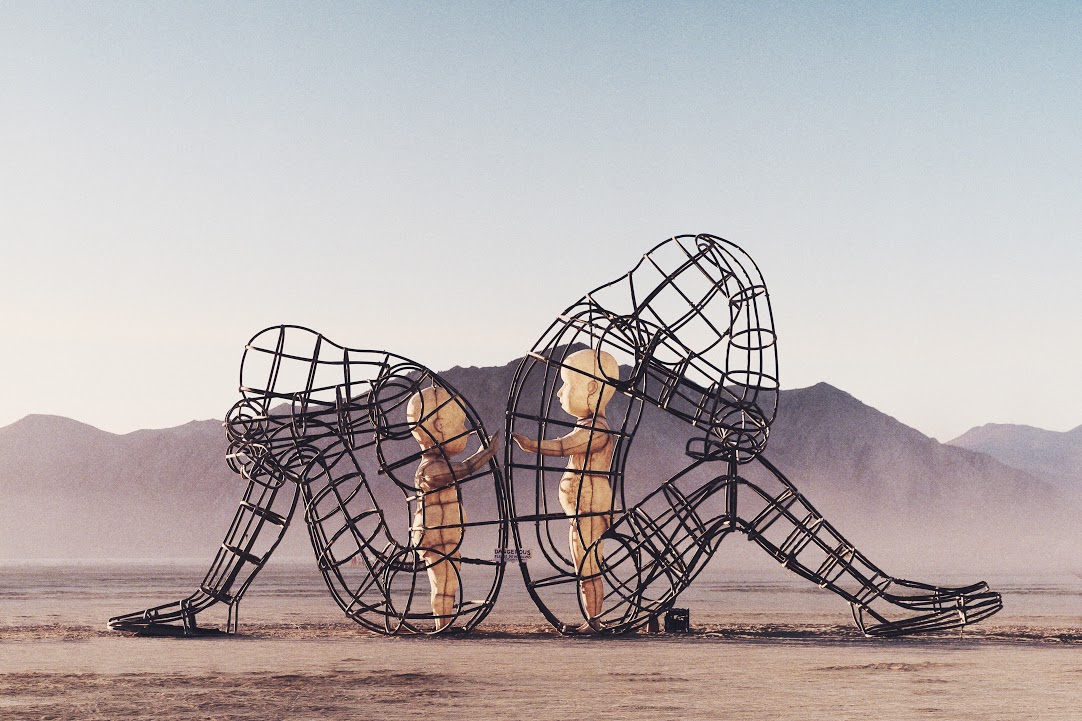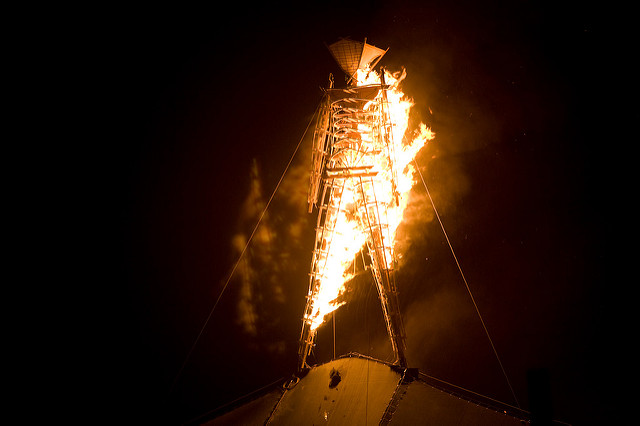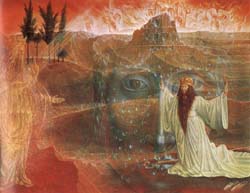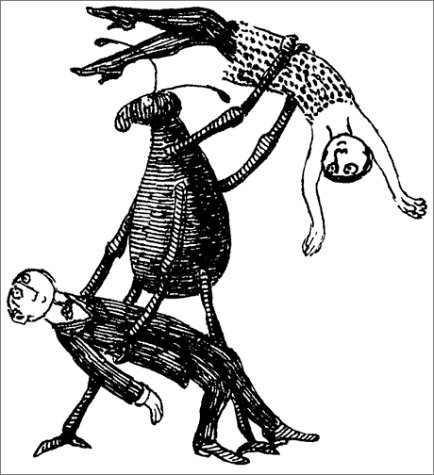
Part Two: THE ORDER OF THINGS
On Monday night of this year’s Burning Man festival, when Larry Harvey saw the figure he first built over twenty years ago burst into flame before its appointed time, the man’s immediate reaction was laughter. A pure and perfect response. Harvey also noted that he laughed only after he knew that the fire was under control and that no one was apt to be hurt. (I’ll be honest: I laughed without knowing if anyone had been injured.) Soon afterwards, Harvey told a blogger that the early burn would turn the festival into a “narrative of community and redemption,” as attendees got to see or assist in the public rebuilding of the statue.
I appreciate where Harvey is coming from, but this sounds like a pretty kumbaya take on what looked to me and many others like an increasingly hidebound institution’s inability to react creatively to a disturbing and unexpected marvel left steaming on their doorstep. So many things could have been done at the time — parade the body of the blackened man to Center Camp, or distribute his dismembered planks to the plazas like the chunks of Osiris, or place the corpse in the arms of the new man.
Sadly, the organization did not improvise with the Event. Instead, they acted a bit like a colony of ants and simply cleaned up the mess and replicated the established model. The repetitive nature of the task, performed behind guard and beneath those garish lights without poetry or mirth, spoke less of community and redemption than of the empire of work. The second man was not a phoenix; it was a clone.
Perhaps this helps explain why the official Saturday night burn of 2007 was probably the most boring on record. Admittedly, I’ve seen these things into the double digits now. But I am also jaded about being jaded and still enjoy the sparkle, the roar, and especially the first surge of the acolytes toward the pyre. But Saturday night’s fireworks had all the whizbang of those little doodads that blink on websites, and the conflagration itself was so drawn out and tepid that many of the revelers around me just walked away or started talking about DJs.
So what made it boring? She that hath an ear, let her hear: Because the base structure was too strong. It was too rigid. It didn’t give. It didn’t surprise. If attendants hadn’t manually pulled the scarecrow down, he would have stood there all night, like the living dead.
But I am not really interested in second-guessing the organization. They build a crazy, immensely entertaining and inspiring city in the middle of nowhere and then tear it down without killing people or getting arrested. They have a lot on their plate.
Here is the question I am interested in: if the Event sparked by Paul Addis did not lead to poetry beyond the gesture itself, did it at least lead to insight? Addis threw up a challenge, legal and political as well as artistic and magical. Were Burners up for it? How did we narrate this unexpected rupture? How did we speak it into history?
I have been frankly amazed at how rapidly so many Burners have deflated the delirious ambiguity of Addis’ act by taking it upon themselves to render judgment upon it in legalistic or at least highly conventional terms. Its a curious response. I mean, the feds are going to have their way with Addis whatever you or me or the “Burning Man community” thinks. So what turned us into op-ed stuffshirts or magistrates proclaiming opinion in a court of law?
Part of the blame for all this dusty punditry can be laid on the feet of the Zeitgeist. In our era of pervasive blogochatter, everyone feels compelled to have an opinion. My friends, it is a terrible habit, having opinions, the compulsive collection of positions that often only masquerade as actually thinking about something.
Moreover, these alignments are often related to deeply established memes which we reproduce without complication by “holding” the opinion. In this way, we unknowingly give over our powerindividual and collectiveto those larger myths and institutions that organize reality according to convention.
What conventions, you say? There is the militaristic logic of escalation: If Addis is not prosecuted to the fullest extent of the law, copycats will destroy the festival! Then there is the fearful invocation of dark possibilities that didn’t actually happen (a rhetorical strategy of control-through-fear we should all be familiar with by now): But something really bad could have happened! Then there was the surprisingly oft-heard “customer service” critique, often made in the name of other people and whose basic logic, as far as I can parse it, goes something like this: Hey now, folks paid good money to see the Man burn on Saturday night, and no selfish burst of Dada détournement should keep them from enjoying their spectacle right on schedule!
Far more significant (and insidious) than any of these conventions, though, is the colossal mythology of property: How dare Addis destroy other people’s art?! I agree that having your playa artwork destroyed by some yahoo with a jug of propane would totally suck, but the totally understandable complaint here actually conceals two very different views, and it’s important to keep them apart.
One view is the sacrosanct status of property that supports the modern nation-state. The other view arises from the collective mores of Black Rock City: an evolving body of informal and contradictory standards that holds certain things about the sanctity (and not) of art. Within the latter framework, it certainly is bad form to destroy someone’s art without asking. However, within BRC mores, it would not be entirely out of place (though a minority view I suspect) to suggest that burning someone’s art may be considered a form of interacting with it. In a federal court, where only the view based on property holds sway, this argument would never make it past a lawyer’s lips.
So let’s stay with this second view for a moment. Doesn’t the oft-trumpeted gift economy of Burning Mannot to mention the insane degree of consumption that fuels itindicate that property has a different meaning out there, that it is less important than expression or community or pleasure? In an interview recently conducted by telegraph and semaphore, Danger Ranger made the point that the raison d’être of the real world’s police and the military can largely be boiled down to the protection of property. In contrast, he characterized the Black Rock Rangerswho partly enforce community moresas an organization founded with the explicit goal of protecting community rather than property.
During our chat, Danger Ranger made an even more important point: the legal status of Black Rock City is fundamentally ambiguous. “Federal, state and county laws are often enforced selectively by the various agencies that represent those civil entities, because most of the individuals within those agencies realize that this a unique community with a different system of values. After spending some time in Black Rock City, it quickly becomes apparent that ‘The Law’ is not a universal standard that can be imposed on the citizens of a community who have collectively agreed to different set of principles.” This legal ambiguity is not just a fantasy of freedomit actually constitutes the shared reality of that place and time, like, arguably, the micronation of Sealand or an MMORPG or the kinky doings in the basement of a private club.
You can get metaphysical about all this. Consider California’s pot clubs or the grow fields that support themthe federal laws simply do not apply in the same way to these spaces, even if the feds sometimes act like they do. The activities in these territories is, like a quantum particle, an ambiguous behavior that is only resolved according to a political struggle over which perceptions, legal and otherwise, can be used to name and clarify it.
So when Burners invoked specifically legalistic categories like “arson” and “reckless endangerment”and I did it too at timesthey were not just rationally debating Addis’ fate. They were actively deflating the productive legal ambiguity of Black Rock City as a self-governing political and territorial space by capitulating, too quickly and without consciousness, to the reality tunnel of the State and, particularly, to its conception of property.
Even in BRC terms the Burning Man is not just another piece of artand it is certainly not just Larry Harvey’s art. Arguably, anyone who pays their ticket and invests that figure with hope and expectation can claim a piece of the thing. The Man is a symbol an an icon, and he is also a logo and a brand whose value Black Rock citizens partly create and sustain through our own creativity and sacrifice. To reclaim or arguably “liberate” this chunk of mindshare by burning it is, while crude and destructive, also to reassert the bootleg value of the figure as a figment of the collective imagination rather than the registered trademark of a for-profit organization.
So here’s a question: If we believe that property at Burning Man is in service of community, did Addis’ destruction of property serve community?
After Addis burnt the man, the Burning Man board could not come to agreement as to the best course of action. The group that wound up ruling the day was not the Board but the crew who actually build the manessentially, DPW. In other words, the decision to rebuild the man arose through the ranks, reflecting that particular crew’s sense of energetic investment into the figure. In this sense, Larry Harvey’s kumbaya was right on, and community asserted itself in the face of destruction.
I wish they had rebuilt the man with more panache, but the act at least reflected the fact that the Man was less someone’s property than the fruit of someone else’s labor. So while the call to rebuild was a corporate decision, requiring the diversion of funds and the deployment of a labor force (volunteer and not), many of the workers were psyched to do it because their labor was not alienated. And in the complex dynamics of Black Rock City, a bloc of unalienated and skilled laborers have a big claim on the (re)construction of reality.
***
The strongest criticisms of Addis’ act went beyond the call of property. An even deeper meme was drawn from, and that is the supreme call to protect human lifeone of the core axioms of our fearful, litigious, paranoid, and death-denying society. Addis should be condemned because he endangered innocent human lives.On the surface, this argument is inarguable, but that is, I would like to suggest, more a sign of its cunning than its logic or essential goodness.
At the moment, there is little to be gained from asking just how dangerous Addis’ actions actually were (would we think differently if we knew he had planned it out like a jewel thief?). That his act was in some sense dangerous is clear. But how dangerous do we want Burning Man to be? And even before we address that question, it is crucial to recognize how the axiomatic invocation of safety as a trump card also performs its own violence, its own kind of snuffing out.
Look, for example, at the constricted lives of so many kids today, with their helmets and knee pads and car-seats, their time managed, their piss checked, their movements tracked by cell phones and prohibitions against aimless wandering. What has been killed in the process of making them less likely to be killed? Perhaps, in our fearful genuflection before safety, we are deadening our taste for the raw and nervy exultation of cognitive and physical libertya liberty which most certainly should include the freedom to attend dangerous and wayward festivals where, if your aren’t careful or even lucky, large burning things might fall on your head.
Now don’t get me wrong. A bomb-chucking Nietzschean anarchist may sneak into my heart sometimes, but my heart lives in my body, and my body doesn’t want burning things falling on its head either. I celebrate all the work people do at Burning Man to prevent needless suffering, and I don’t want my friends and compatriots hurt. At the same time I cannot quiet the cosmic imp whispering in my ears:
Does not Burning Man stand alone because, even now, the event still tangos with chaos, with Dionysian fury and explosive devices and actual risk? With, you know, Danger?
Sure there were people under the untimely burning man who were pelted with fireworks. Did they read their ticket? Are those words just for show? Do you read them that way? Think of the last time you back-packed: doesn’t knowing that old Griz lurks in the hills gives the hike through the high country spice?
I know, I know: my old school is showing. I first showed up at Burning Man in 94, when the event was ugly, deranged, and totally transformative: cacophony and suicide and discordia rolled into one mobile feast of AK-47s, mescal, and cigars. Larry Harvey may not care for the term, but I believe in the temporary autonomous zone. I felt it; I was there.
Don’t get me wrong: I am not pulling an elitist move or claiming the festival was “better” back then. It wasn’t. I remain continuously amazed at its evolution. I am fascinated by the fiery city. But those years catalyzed such bizarre ruptures of reality that they demand a fidelity that I and some quasi-jaded old-school Burners who still attend the festival cannot and will not shake.
My sadness these last few weeks is mostly a recognition of how many of today’s Burners do not share that fidelity, which in retrospect makes Addis’ act even more meaningful to me than the poetic prank it seemed that Monday night.
I believe that 2007 will go down as a watershed year in the evolution of Burning Man, not unlike the transition from 1996 to 97, when the urban model was locked in and the guns were banished. This year, we witnessed the visible embrace of entrepreneurial capital. We witnessed the Great Prank that this embrace partly triggered, and that in turn triggered a banal official response. We heard a rhetorical upswing concerning the festival’s social relevance, and a corresponding back-pedaling on the spirit of useless expenditure that characterized its past. We witnessed the increasing influence of Burning Man on the culture at large, from the Adult Swim cartoon to Burners Without Borders to the spread of Burning Man-style art to festivals and urban landscapes. All of these mark 2007 as a tipping point, as a crystallization of a different regime.
There is great good and enormous potential in this transformation. It signals the maturity of Burning Man’s urban metaphor, the infectious strength of its countercultural creativity, and its strong desire to bring the playa back into the world. The playa has burst; the seeds are scattering. I say spread ’em! Keep drawing others into the fete. Let’s transform the world with a mobile army of art perverts and post-apocalyptic entrepreneurs and hard partiers handy with drills, grey water, and incendiary devices.
But to boldly go into that brave new burning world, you gotta pass your ass through the time-slip wormhole of chaos that Paul Addis invoked in flame beneath an ominous moon.
***
Addendum — October 1, 2007
Since posting my two-part exploration of the Great Prank of 2007, I have had a number of thoughtful and substantial email exchanges and conversations, mostly with DPW folks. Larry Harvey also gave me a buzz. Inevitably, these conversations gave me new perspectives and fresh insights on this complex, multilayered affair.
The most significant ethical issue remains the issue of risk to human life. According to Harvey, there were not only people beneath the structure when the man was set aflame, but some people who were kinda out of it and needed active assistance from the Rangers who had entered the structure beneath the burning figureRangers Harvey considers heroes. The deeper question, then, is this: if we still want Burning Man to be a dangerous place, what sort of danger is desirable and what sort is not (and how you enforce the difference)? Epiphany Heiermann, who had herself been injured from an aggressively dangerous prank at a regional burn, wrote the following to me:
I think burn events should be more dangerous. I think people need a space where they can challenge themselves, put themselves in danger and push their boundaries. But it is not okay for people to put others in danger because they think it’s fun, and they feel that others need their boundaries pushed. It’s akin to giving somebody LSD without telling him/her that you are going to do it.
The LSD analogy is quite apt. Still, the lingering chaos question remains: if you find that you have ingested LSD you were not made of aware of, or been injured in a wayward prank that was not individually targeted at you, how do you respond? What sorts of authorities do you invoke to step in? And how does a community deal with the sort of abusive people who get off on exploiting these very ambiguities?
These are complex questions, and they ride that important line between community mores and legal categories. Epiphany believes that the lack of response from the organizers of the regional in question “came from trying to hold onto an idealized anarchist image of their event where everybody gets all the freedom they want.” “Anarchy” too can become an easy dodge.
Another one of my impressions that stirred some response was that the rebuilding of the man was an utterly prosaic act beyond the camaraderie experienced by the build crew itself. But there was more poetry than met the eye, or my eye anyway. According to one email, the carpenters took the lowest ‘rib’ of the burnt man and used it for the new man; other chunks were handed out to folks who were close to the event, including the Ranger who caught the perp. The build crew also took a panel that was scorched, carved out a silhouette of a phoenix and used it for the new man’s face. According to Harvey, the biggest act of poetry was the build crew’s insistence that they reconstruct the man on the white-out-plagued playa rather than from the safety and relative comfort of the Ranch. The rebuild itself was a performance of commitment.
Harvey also argued that the repetition implied in rebuilding the man, which I compared to a clone, is crucial to the ritual function that the stick-figure performs. When we are too quick to see the man as merely a logo or a trademark, and not a cultural symbol that derives part of its power from repetition, we are in some ways reflecting our own corporate trance. One of my main points in the essay was that by jumping too quickly to legalistic language, we miss more local, nuanced and community-based ethical conversations. Similarly, if we too quickly invoke corporate metaphors — though they in some ways apply — we miss the more ritualistic and symbolic way that the burning man figure forms and stabilizes cultural identity.
The problem with this view is that, from where I sat, the rebuilding basically appeared to be a dull and even arrogant institutional response. One email from a newish DPW worker I’ll call Studmuffin noted one reason why: DPW folks were warned not to talk to other attendees about the early burn, to refer to the burn as “the Incident,” and to offer no details to others. While there are OK legal reasons for this — including protecting Addis’ rights — the result of this wall of silence, coupled with the physical perimeter around the rebuild site, was to create the sort of alienating aura of official silences, hierarchical boundaries, and institutional control we are familiar with from the outside world.
Unfortunately, many of these institutional effects are probably inevitable, just as some of the unfortunate transformations of the Ranger culture (including their disturbing imbrication with the official police forces) are inevitable. These are partly statistical effects, having to do with population, political pressures, and the nature of institutions. That these effects are in some sense inevitable only opens a deeper question: will enough of Burning Man’s core values survive its growth and mainstreaming to make it worthwhile? And what does “worthwhile” mean, and to whom? What does it mean to you?
Larry Harvey recognizes the challenges of growth, arguing that Burning Man has faced them before. More poignantly, he noted that if you can’t create a workable civilization for a city of 50,000, then we are indeed screwed. I agree with the effort to take Burning Man to the world, but my assent has more than a small bit of melancholy to it. Because its important to acknowledge and mourn what is being pushed away to make room for the new, and to be very aware of who is doing the pushing and why.
For example, Studmuffin described clear signs of a clampdown on the raw and randy ways of the DPW: they banned some rowdies for some small potatoes mischief, and instituted new rules for the crew’s famously feral and obnoxious parade.
Maybe you saw it, but you probably didn’t because we were directed to travel down only the least-populated streets to minimize conflicts with burners. We were told we couldn’t “beg” for beer and cigarettes. They assigned staff wearing red T-shirts to run alongside all of the vehicles to keep people back. It sucked. Last year, I was bumping into other cars on the route. People were running into camps and snatching beer from coolers. Huge crowds came out. It was a spectacle. It was INTERACTIVE.
Running into (and almost being run over by) the drunken DPW parade last year was a personal high point. I have also camped next to DPW crews for the last couple years, count a few as friends, and its always worked out swell, even the ugly music. (Trick: feed them beer.) For my money, when the DPW gets their wings clipped, than something essential dies. But’s the way of things, no? Here is Studmuffin again:
I’ve learned something in the last couple years — that it is important to accept change and grieve what is gone and then move on. Paul burning the Man early, felt to me, like a toddler having a tantrum. Then the more I thought about it, the more I thought that his act could just as well embrace the idea of change. Burning the Man early is just that: change. By protesting it, he was participating in it. So I dropped that opinion.
There are a lot of opinions still to churn through, and to drop. Larry Harvey and I have discussed the possibility setting up a public meeting in the Bay Area where some of these issues can be discussed and hashed out. The quest for meaning among the ruins continues.
Previously: Part One: CHAOSMOS




